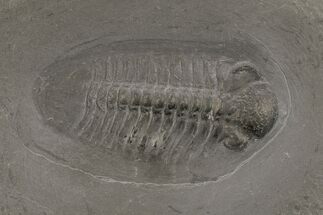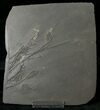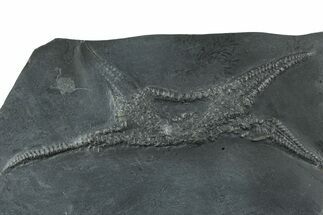This Specimen has been sold.
2.2" Pyritized Crinoid Assemblage From Hunsrück Slate
This is a beautiful, assemblage of about half a dozen fossil crinoids from the famous Hunsrück Slate of Germany. They are of the species Parisangulocrinus zeaeformis and the longest specimen on is 4.7" long. These very detailed crinoid specimens are located on a 7.2x6.6", unbroken piece of slate. It's really tough to get material from the location anymore as it's been closed for well over a decade.
The lower Devonian (lower Emsian) slates from Bundenback have been quarried for roofing material for centuries. Quarrying continued until the 1960s, when the competition from cheaper synthetic or imported slate resulted in production decline. The last pit closed in 2000. Mining of Hunsrück slate was important for the discovery of Paleozoic fossils. Although not rare, fossils can only be found through extensive mining of slate and time consuming preparation. Fossils are hard to see lying under the surface of dark slate. In 1970, Wilhelm Stürmer, a chemical physicist and radiologist developed a new method to examine the Hunsrück slate fossils using medium energy X-rays. The Bundenbach “Hunsruck Slate is famous for yeilding one of the most important assemblages of Paleozoic fossils, featuring 260 animal species, including many arthropods, corals, mollusks, and echinoderms - like this beutifully presented sea star.
The lower Devonian (lower Emsian) slates from Bundenback have been quarried for roofing material for centuries. Quarrying continued until the 1960s, when the competition from cheaper synthetic or imported slate resulted in production decline. The last pit closed in 2000. Mining of Hunsrück slate was important for the discovery of Paleozoic fossils. Although not rare, fossils can only be found through extensive mining of slate and time consuming preparation. Fossils are hard to see lying under the surface of dark slate. In 1970, Wilhelm Stürmer, a chemical physicist and radiologist developed a new method to examine the Hunsrück slate fossils using medium energy X-rays. The Bundenbach “Hunsruck Slate is famous for yeilding one of the most important assemblages of Paleozoic fossils, featuring 260 animal species, including many arthropods, corals, mollusks, and echinoderms - like this beutifully presented sea star.
SPECIES
Parisangulocrinus zeaeformis
LOCATION
Bundenbach, Germany
FORMATION
Hunsrück Slate
SIZE
Longest crinoid 4.7"
CATEGORY
SUB CATEGORY
ITEM
#17540
We guarantee the authenticity of all of our specimens.
 Reviews
Reviews











